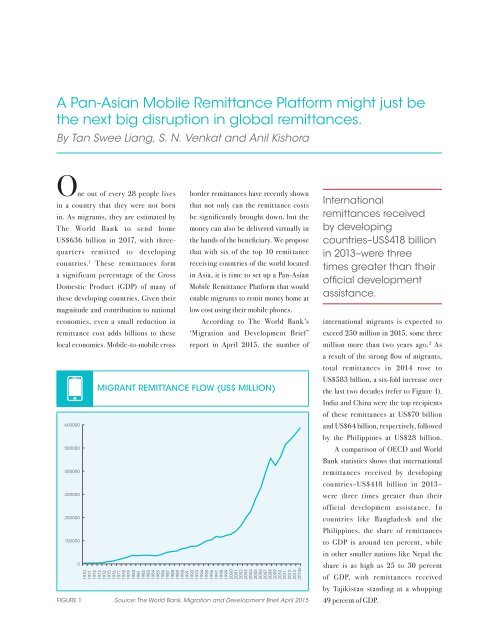SMU_AMI_November_Spread
Create successful ePaper yourself
Turn your PDF publications into a flip-book with our unique Google optimized e-Paper software.
A Pan-Asian Mobile Remittance Platform might just be<br />
the next big disruption in global remittances.<br />
By Tan Swee Liang, S. N. Venkat and Anil Kishora<br />
One out of every 28 people lives<br />
in a country that they were not born<br />
in. As migrants, they are estimated by<br />
The World Bank to send home<br />
US$636 billion in 2017, with threequarters<br />
remitted to developing<br />
countries. 1 These remittances form<br />
a significant percentage of the Gross<br />
Domestic Product (GDP) of many of<br />
these developing countries. Given their<br />
magnitude and contribution to national<br />
economies, even a small reduction in<br />
remittance cost adds billions to these<br />
local economies. Mobile-to-mobile cross<br />
600000<br />
500000<br />
400000<br />
300000<br />
200000<br />
100000<br />
0<br />
Migrant Remittance Flow (US$ million)<br />
1970<br />
1971<br />
1972<br />
1973<br />
1974<br />
1975<br />
1976<br />
1977<br />
border remittances have recently shown<br />
that not only can the remittance costs<br />
be significantly brought down, but the<br />
money can also be delivered virtually in<br />
the hands of the beneficiary. We propose<br />
that with six of the top 10 remittance<br />
receiving countries of the world located<br />
in Asia, it is time to set up a Pan-Asian<br />
Mobile Remittance Platform that would<br />
enable migrants to remit money home at<br />
low cost using their mobile phones.<br />
According to The World Bank’s<br />
‘Migration and Development Brief’<br />
report in April 2015, the number of<br />
1978<br />
1979<br />
1980<br />
1981<br />
1982<br />
1983<br />
1984<br />
1985<br />
1986<br />
1987<br />
1988<br />
1989<br />
1990<br />
1991<br />
1992<br />
1993<br />
1994<br />
1995<br />
1996<br />
1997<br />
1998<br />
1999<br />
2000<br />
2001<br />
2002<br />
2003<br />
2004<br />
2005<br />
2006<br />
2007<br />
2008<br />
2009<br />
2010<br />
2011<br />
2012<br />
2013<br />
2014e<br />
Figure 1 Source: The World Bank, Migration and Development Brief, April 2015<br />
International<br />
remittances received<br />
by developing<br />
countries–US$418 billion<br />
in 2013–were three<br />
times greater than their<br />
official development<br />
assistance.<br />
international migrants is expected to<br />
exceed 250 million in 2015, some three<br />
million more than two years ago. 2 As<br />
a result of the strong flow of migrants,<br />
total remittances in 2014 rose to<br />
US$583 billion, a six-fold increase over<br />
the last two decades (refer to Figure 1).<br />
India and China were the top recipients<br />
of these remittances at US$70 billion<br />
and US$64 billion, respectively, followed<br />
by the Philippines at US$28 billion.<br />
A comparison of OECD and World<br />
Bank statistics shows that international<br />
remittances received by developing<br />
countries–US$418 billion in 2013–<br />
were three times greater than their<br />
official development assistance. In<br />
countries like Bangladesh and the<br />
Philippines, the share of remittances<br />
to GDP is around ten percent, while<br />
in other smaller nations like Nepal the<br />
share is as high as 25 to 30 percent<br />
of GDP, with remittances received<br />
by Tajikistan standing at a whopping<br />
49 percent of GDP.


